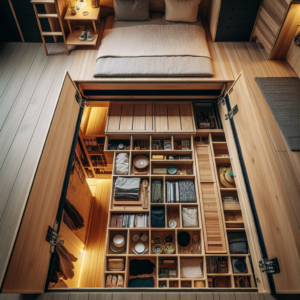When living in a tiny home, every square inch counts, and finding innovative ways to store your belongings can be a game-changer. One brilliant strategy is to create a sustainable under-floor storage solution beneath your loft. This approach not only maximizes your space but also maintains the minimalist and uncluttered aesthetic that tiny home living is all about. Let’s dive into how to achieve this with eco-friendly materials and smart design.
Key Takeaways
-
Under-floor storage in tiny homes offers a way to use dead space effectively, keeping your living area open and uncluttered.
-
Using sustainable materials like reclaimed wood and non-toxic finishes ensures your storage solutions are eco-friendly.
-
Designing the space thoughtfully allows for easy access and maximizes usability without compromising on home aesthetics.
-
DIY installation of under-floor storage can be straightforward with the right tools and guidance.
-
Under-floor storage solutions can be integrated with other tiny home innovations for a comprehensive approach to space-saving.

Maximizing Tiny Home Space with Sustainable Under-Floor Storage
Imagine lifting a panel in your floor to reveal a hidden storage compartment where you can keep your off-season clothing, extra bedding, or even your book collection. Not only does this make use of an otherwise wasted space, but it also adds an element of surprise and innovation to your home. But where do you start? The answer lies in choosing materials that are both sustainable and durable.
Eco-Friendly Materials for Under-Floor Compartments
First things first, you’ll want to select the right materials. Sustainability isn’t just a buzzword; it’s a commitment to using resources that are renewable and kind to our planet. For your under-floor storage, consider materials such as:
-
Reclaimed wood: It’s not only sturdy and full of character but also reduces the demand for new lumber.
-
Bamboo: This fast-growing plant is a fantastic wood alternative that’s both strong and sustainable.
-
Recycled composite materials: Some composites are made from recycled plastics and wood fibers, making them a durable and eco-friendly choice.
When it comes to finishes, go for low-VOC (volatile organic compounds) or natural oil finishes to keep your indoor air quality fresh and free from harmful chemicals.
Design Principles for Optimal Space Utilization
Designing your storage space is not just about fitting a box under the floor. It’s about understanding how to access your belongings easily and how to maintain the structural integrity of your home. Here are some principles to keep in mind:
-
Accessibility: Make sure you can easily open the storage compartments without moving furniture around.
-
Customization: Tailor the size and shape of your compartments to fit the items you plan to store.
-
Weight distribution: Consider the weight of stored items and ensure it’s evenly distributed to avoid any damage to your home’s structure.
Now, let’s get our hands dirty and start building your under-floor storage.
Step-by-Step Guide to Building Your Under-Floor Storage
Gathering Sustainable Materials
Before you begin, gather all the materials you’ll need. Here’s a quick list to get you started:
-
Measuring tape and pencil for accurate planning
-
Saw for cutting your chosen materials to size
-
Screws and drill for assembling the compartments
-
Non-toxic adhesive for additional support
-
Hinges and handles for easy opening
-
Sanding tools for a smooth finish
Remember to source these items from eco-friendly suppliers whenever possible.
Planning the Storage Layout Under Your Loft
Measure the space under your loft carefully. You’ll want to ensure that your storage compartments fit snugly without interfering with any existing structures or systems. Sketch out a plan that includes the dimensions of each compartment and where they will be located. Consider how deep you can go without impacting the insulation or plumbing.
DIY Installation Tips and Tricks
Installation can be straightforward if you’re handy with tools. Here’s a simplified step-by-step guide:
-
Mark out the area where each compartment will go and double-check your measurements.
-
Cut your materials to size according to your plan.
-
Assemble the frames for your compartments, ensuring they’re sturdy and well-supported.
-
Attach the hinges and handles to the lids of your compartments.
-
Install the compartments into the floor, securing them with screws and adhesive.
-
Apply your chosen finish, and allow it to dry completely before use.
And voilà! You now have a sustainable under-floor storage solution that’s perfect for your tiny home loft.
The Advantages of Going Underground with Storage
Most importantly, utilizing under-floor storage in your tiny home loft brings several significant advantages. The most obvious is the expansion of your usable living area. By moving items that are not in daily use into the floor, you free up space for living and entertaining. Besides that, this hidden storage solution preserves the aesthetic integrity of your home, keeping it looking neat and tidy without bulky storage units or closets.
Expanding Your Living Area
Under-floor storage is essentially like finding an extra closet you never knew you had. By stashing away seasonal gear, spare linens, or even kitchen appliances that are seldom used, you can maintain a clear and open living area. This is especially crucial in a tiny home, where the feeling of spaciousness is a key component of comfort.
Protecting Your Belongings with Climate Control Options
When considering under-floor storage, it’s also important to think about the conditions within. Depending on what you’re storing, you might need to take steps to control the climate. For example:
-
Adding insulation around the storage area can help regulate temperature fluctuations.
-
Using silica gel packets or a small dehumidifier can protect against moisture.
-
Sealing the edges of your compartments can prevent pests and dust from getting in.
These measures ensure that your belongings stay in top condition, even when stored out of sight.
Smart Organization Hacks for Under-Floor Storage Systems
Utilizing Dividers and Customizable Containers
Organization within your storage space is key to finding things quickly and keeping the area tidy. Implementing dividers or using containers can turn a large space into an organized haven. Consider using:
-
Bins and baskets made from sustainable materials like bamboo or recycled plastic.
-
Adjustable dividers that let you customize the space according to your needs.
-
Labels or color-coding to easily identify contents at a glance.
This approach not only keeps your items in order but also makes it easier to rotate things in and out based on seasonal use.
Implementing Easy Access Pull-Out Mechanisms
For those deeper storage areas, an easy access pull-out mechanism can be a real back-saver. Think about installing sliders that allow you to pull out bins or shelves. This simple addition can make it much more convenient to reach items that are stored further back in the compartment.
Pairing Storage with Sustainability in Tiny Homes
Choosing Low-Impact Building Techniques
Building your under-floor storage should not only focus on the end result but also on the process. Opt for building techniques that minimize waste, such as:
-
Measuring twice and cutting once to reduce material usage.
-
Recycling or repurposing offcuts for other projects within the home.
-
Choosing hand tools or electric tools with low energy consumption over gas-powered equipment.
These techniques are not only better for the environment, but they can also save you money in the long run.
Integrating Energy-Efficient Storage Solutions
Besides the materials and building process, consider how your storage solution can contribute to the overall energy efficiency of your tiny home. For instance, incorporating thermal mass materials within your storage compartments can help stabilize indoor temperatures. You might also explore smart storage solutions that integrate with your home’s energy management system, such as battery storage or thermal storage.
By taking a holistic approach to your under-floor storage, you can create a system that’s not just about stashing away belongings but also contributes to the sustainability and efficiency of your entire home.
With these guidelines in mind, you’re well on your way to designing and implementing an under-floor storage solution that is both sustainable and incredibly functional. Remember, the key is to plan carefully, use eco-friendly materials, and build with precision. Your tiny home will not only be more organized, but you’ll also have the peace of mind that comes from knowing you’ve made choices that are good for you and the planet.
Frequently Asked Questions (FAQ)
As you embark on your journey to create a sustainable under-floor storage solution for your tiny home, you might have some questions. Let’s address some of the most common ones to ensure you’re fully informed and ready to tackle this project with confidence.
What Materials Are Best for Sustainable Under-Floor Storage?
When it comes to choosing materials for your under-floor storage, sustainability is key. Look for locally sourced materials to reduce transportation emissions. Reclaimed wood is an excellent option as it prevents the need for new timber harvesting. Bamboo and recycled composites are also top choices due to their durability and low environmental impact. Remember to seal and finish your storage with low-VOC products to maintain good indoor air quality.
How Can I Ensure My Storage Doesn’t Impact My Tiny Home’s Insulation?
To avoid compromising your tiny home’s insulation, carefully plan the location of your storage compartments. Ensure that there’s still room for adequate insulation material around the storage space. You can use rigid foam boards or spray foam insulation, which can effectively seal nooks and crannies, ensuring that your home stays warm in the winter and cool in the summer.
What Are the Best Ways to Access Under-Floor Storage?
Accessibility is crucial for under-floor storage. Design your compartments with hinged tops or sliding panels for easy access. If you’re storing heavier items, consider installing a hydraulic lift system that allows you to raise and lower the storage compartment with minimal effort. Always ensure that the opening mechanism is simple to operate and doesn’t require moving furniture or rugs.
Can Under-Floor Storage Be Combined with Other Tiny Home Innovations?
Absolutely! Under-floor storage can be seamlessly integrated with other space-saving innovations in your tiny home. For example, foldable furniture or multi-functional pieces can work hand-in-hand with hidden storage to maximize your living space. Additionally, you can explore smart home technologies that allow you to monitor and control the conditions within your storage compartments remotely.
-
Integrate foldable furniture that can be stowed away when not in use, freeing up floor access.
-
Use multi-functional pieces like a sofa with built-in storage that complements the under-floor compartments.
-
Consider smart sensors to monitor humidity and temperature within your storage, ensuring optimal conditions for your belongings.
How Do I Maintain a Moisture-Free Environment for My Stored Items?
Moisture control is vital to protect your stored items from mold and mildew. Start by ensuring that your storage compartments are well-sealed to prevent moisture ingress. Use vapor barriers or sealants around the edges of the compartments. Inside, place desiccants like silica gel packs to absorb any excess moisture. For long-term storage, consider a small, battery-powered dehumidifier to maintain a dry environment.
Regularly check the condition of your stored items and the interior of the compartments for signs of moisture. If you live in a particularly humid climate, it might be worth investing in a hygrometer to monitor humidity levels and take action as needed.





